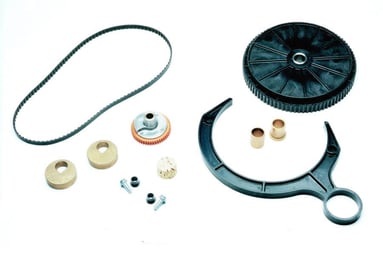Pros and Cons of a W.S. Tyler RO-TAP® Sieve Shaker (With Video)
Deciding to buy particle analysis equipment can be an overwhelming process. There are a lot of different particle analysis machines and systems out there that all have unique pros and cons.
We want to help you during this decision making process by breaking down those pros and cons for one of our products, the W.S. Tyler RO-TAP® Sieve Shaker.
In this article, we are going to take a look at the pros and cons of a RO-TAP Sieve Shaker.
We offer both mechanical and electromagnetic units of the RO-TAP, as well as many different models of each of those. This article will soly be talking about one of the most widely used devices, the RO-TAP RX-29 and RX-30.
Is The RO-TAP Right For Me?
The RO-TAP RX-29 and RX-30 are mechanical sieve shakers that are used to separate particles in a test sieve stack in industries all over the world. While the RO-TAP is a great solution for virtually any particle analysis operation, it is important that you are aware of the pros and cons of the RO-TAP Sieve Shaker to best determine if it's a good fit.
Pros
Durability/Lifespan
The machine is built in our facility in Mentor, Ohio by our specialist. The machine was created to operate with two strong motions, oscillation(rotating) and a tapping motion.
RO-TAP’s have a very long lifespan. We have customers who have had their sieve shakers for over 40 years. These are mechanical and robust machines that are designed to withstand a lot of movement and wear.
Cost
There are a few reasons we have listed cost as a proof the RO-TAP Sieve Shaker. The first is that price is reasonable in terms of the unit itself.
A RO-TAP Sieve Shaker is going to cost you anywhere from $1,975.28 to $11,005.80.
When looking at all types of particle analysis equipment, a RO-TAP falls on the lower end of the cost range. RO-TAPs are less expensive than buying the more complex methods of particle analysis, like a Computerized Particle Analyzer. You could expect to pay at least $60,000 (at minimum) for one of those.
We have written an entire article on the cost of the RO-TAP and all the options included. You can read all about it in: How Much Does a RO-TAP® Sieve Shaker Cost.
A second reason, which goes along with durability, is that for the price, this machine has a very long lifespan. We already addressed above how this machine can last a very long time, and it’s not super expensive either.
Consistent Results
 It may seem like a no-brainer, but the most obvious benefit of using a RO-TAP is that you are eliminating the need to perform a hand sieve analysis.
It may seem like a no-brainer, but the most obvious benefit of using a RO-TAP is that you are eliminating the need to perform a hand sieve analysis.
The machine shakes the particles down through a test sieve stack and the results are analyzed at each sieve level. Because the machine is doing the manual work, this creates repeatable results each time. When you are doing a hand sieve analysis, there is a possibility for human error, and a sieve shaker eliminates that.
There can still be errors that occur in your process depending on your particle size and material being sieved. To ensure that you are using your sieve shaker properly and for the correct amount of time, you will need to perform an end of sieve analysis. This will ensure that you have consistent/repeatable results.
Time Saving
Using a sieve shaker decreases the time it takes to perform a sieve analysis. This allows you to not only perform and analyze results faster, but also allows you to complete more tests each day.
Sieving by hand requires more time and more diligence in your process to ensure accurate results.
Cons
Noise
This one is something we address often when we talk about the RO-TAP. The RO-TAP is noisy. The machine uses a hammer to tap particles down through a stack of test sieves while it oscillates and shakes. This tapping motion creates quite a bit of noise.
If you have your unit in a sound enclosure cabinet, it could be a little quieter. But the machine runs at a volume of around 85 dB.
Some people find that the noise of the machine is too loud. We find this to be the case in small labs or situations where the machine runs nearby others working.
We wrote an article all about the noises the sieve shaker makes: 5 Reasons Your Sieve Shaker Is Noisy.
Maintenance

Once a sieve shaker has been used for about a year, it will start to need upkeep. There are a lot of parts inside of the machine and over time, they will suffer wear and tear.
Although replacing the parts is not usually difficult, it does require some downtime and some understanding of the machine. We offer diagrams and our customer service team for support.
It isn’t a massive amount of maintenance, but as opposed to a more advanced machine like the CPA, there is going to be more downtime.
Size/Foot Print
The RO-TAP Sieve shaker measures 28”w by 21"d by_25”h and weighs 170 lbs. It is not a small machine.
The sound enclosure cabinet measures 35"w by 24"d by 29"h.
We find this to be fine for most customers and labs. But, if you are operating in a very small space or need to move this machine frequently, you may find this to be a con of the machine.
If this sounds like you, we recommend one of our electromagnetic RO-TAP sieve shakers.
To Sum It Up
Sieve shakers are a prominent particle analysis instrument that have helped lab technicians yield accurate and repeatable results for decades. To best determine if test sieve analysis will fit your operation you must be aware of the pros and cons of the equipment you are considering.
That said, once you have identified a sieve shaker that is right for you, the next step is to begin building a sieve stack that complies with your industry standards. But what test sieves should you use with your RO-TAP device?
With over 140 years of experience helping customers navigate the world of particle analysis, W.S. Tyler strives to ensure you have the know-how needed to integrate a reliable test sieve analysis process.
To ensure you build the perfect stack of test sieves, review the following articles:





